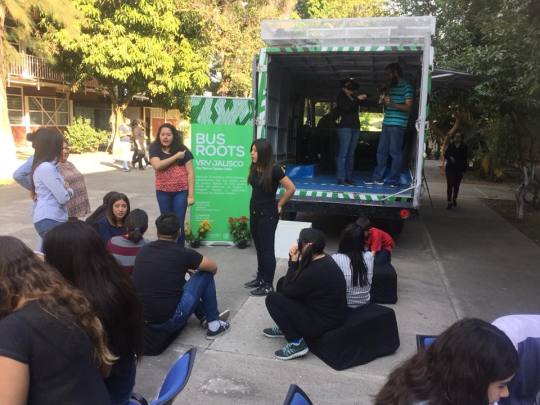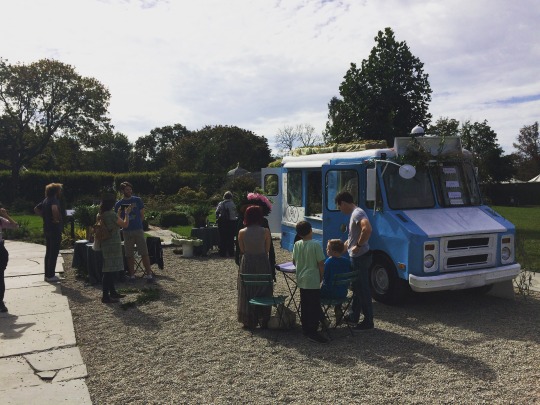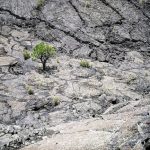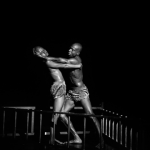Conversations | Marco Antonio Castro, Multidisciplinary Artist and IAP Mentor
“I’m very interested in connecting the different innovations, culture, and creative labs around the city and resurfacing the connective tissue that brings them together.“
Marco Castro is a well-rounded interactive designer who has experienced creative residencies at TED, Columbia, and NYU. He is an Immigrant Artist Mentoring Program Mentor and the mind behind the Bus Roots VRV, a project that installs green roofs on top of moving vehicles. We talked to him about his creative process, his experience with art and technology, his role in IAP, and more.
NYFA: How do you see the relationship between art and technology, considering your experience with different cultural institutions and as an individual creator?
Marco Castro: After being a fan of their work, I am now a tech associate at Eyebeam, a nonprofit studio for collaborative experiments with technology towards a more imaginative and just world. Spaces like these are crucial for the healthy development of our communities; they allow our designers and technologists to design out in the real world and towards solutions that improve our society.
NYFA: What made you mainly focus on interactive telecommunications?
MC: I am fascinated by the potential of two-way communication, by the potential routes and destinations a conversation can take its participants to. I have found myself working with cultural organizations that care for objects and stories from the past, and they serve as a time machine for the visitors. Museums, libraries, and cities serve as hubs for the past, present, and future to share the same space in time.

NYFA: What’s your most recent project and what’s the idea/concept behind it?
MC: Recently, I have explored creative residencies at TED, Columbia, and NYU. I launched prototypes of the Bus Roots VRV, a project that installs green roofs on top of moving vehicles. Now with a virtual reality component, it allows visitors to virtually draw a greener city. In Central Park in New York and in Guadalajara, Mexico, with the support of public and private art organizations, municipal, state and federal institutions, Bus Roots VRV reached 1,500 visitors in 2017.
NYFA: Can you tell us more about your creative process?
MC: My creative process is about inquiry and asking how the experience of doing mundane activities can be improved or made more fun for the people or users involved. I ask myself questions that might not have an answer, but they open up possibilities for different solutions. Once I have gathered potential solutions, I cluster them and begin to draft up a new scenario for that experience and experiment.
NYFA: Do you also work (or have you ever worked) in other more traditional art media?
MC: I have not done so professionally but I admire and respect artists who use their body as their medium, or designers who create spaces and experiences that make our bodies react and be more connected to our senses.
NYFA: You also curate exhibitions and art festivals. What are the connections between your curatorial practice and your art projects?
MC: I have been active in the New York arts community since my arrival in 2005. This involvement was cemented when I permanently relocated to join NYU’s ITP graduate program in 2008. I co-founded and curated MoD (Monitor Digital), the first Interactive Art Festival in Guadalajara, Mexico. We brokered partnerships in the public and private sector to give new audiences an access point to explore digital art and performances. From 2007 to 2013, I guided the vision, curatorial strategies, fundraising, and assessment for the annual festival, while tapping the diverse arts community that thrives in New York. MoD’s public programs, workshops, performances, and artists expanded the festival’s reach to ultimately serve as a pipeline for international artists to connect and collaborate across borders. The festival helped me understand the process and care needed to reach new audiences and how to make a digital exhibition as inviting as possible without lowering the quality of the content. This has helped me in my practice to make sure I know how to talk about my projects in different ways, to make them understandable by different audiences.

NYFA: How much do viewers and participants influence the outcome of the projects?
MC: With Bus Roots, the proposal to install lightweight gardens on top of city buses and other vehicles, I talked to different designers, engineers, architects, artists, and gardeners to arrive at the latest design. This past year when I was designing the Bus Roots VRV, a food truck with a garden on its roof and a virtual reality studio, I went through the same process and talked to game designers, technologists, and developers to get feedback on the project. Once we launched the prototype in New York and Guadalajara, Mexico, we learned a lot about what users reacted to and how the experience could be improved.
NYFA: Your practice includes lots of intensive research. Can you tell us more about that?
MC: I’m a very curious person and my practice relates to different disciplines. I get to make inquiries in different industries and get to learn new topics often. Thanks to this, I find myself looking at my practice from different angles.
NYFA: What stories would you like to tell the audience through your projects?
MC: The project I have been working with the longest, Bus Roots, is a platform for people to imagine their city in a new greener version. I hope people feel encouraged to imagine new solutions for us to adapt to climate change and make our lives better.

NYFA: What’s your relationship with NYU-POLY incubator? How do you see this institution’s role in New York, and in the current interactive art field in general?
MC: After the residency at TED, where I was preparing a talk on Bus Roots VRV, I was invited to work out of the NYU Tandon Digital Future Labs. I’m an artist in residence and we are working on making pollinator lab space where artists and technologists can meet to pollinate new ideas and leads for creative applications of technology. I’m very interested in connecting the different innovations, culture, and creative labs around the city and resurface the connective tissue that brings them together. I’d love to highlight what I see as the Internet of Labs.
NYFA: How can artists engage and collaborate with institutions that will give them support for their interactive projects?
MC: The time I worked as manager of the Met MediaLab at the Metropolitan Museum, I found that the best way to work and collaborate with the institution and with my colleagues in other departments was to be open and be a good listener. Once people understand you are actively looking to collaborate and they know you care about the same things they care about, trust is developed and common goals can be achieved.
NYFA: What options are there for an artist that has an idea but not the technical knowledge and resources to make it happen?
MC: I am always interested in seeing paper prototypes, or even drawings and sketches of the idea first. That will help the artist communicate the idea to people or experts with other skills. It will also allow for others to help the artist think of different solutions. Once that sharing process is tried out, perhaps the artist will have learned some basics about the technology needed to achieve their goal.
NYFA: What are the challenges you face when bringing your complex projects into the street? Do you consider your work to be socially engaged?
MC: The work I’m trying to do can fall into different categories and that means that people’s understanding of it sometimes can fall through the cracks. Dealing with moving vehicles or with technology that is shared between different entities makes prototyping not an easy task. I aspire for my work to be socially engaged. In Mexico, we visited twenty locations across the city, inviting citizens to imagine, draw, and build a collective virtual botanical garden. However, I believe that there are artists in places like the Queens Museum, A Blade of Grass or Flux Factory that are working much closer to their communities and I would call their work socially engaged work. I hope my work can connect more with the communities.
NYFA: In the fall, you participated as a Mentor for the Immigrant Artist Mentoring Program for Visual and Multidisciplinary Arts. What kind of advice do you give your mentees?
MC: I was part of the mentoring program in the fall working with Dulphe Pinheiro and had the opportunity to have doctor’s hours with Eva Davidova a couple of years ago. I always find myself sharing the advice that helps me in my own work, which is to always be listening. This is the only way we can understand the cues we get from our own practice, from our environment, and from the communities we belong to.
NYFA: You mentioned an upcoming collaboration or presentation of your mentee…
MC: We are still working out the details, but since there is a Dumbo First Thursday Gallery Walk right around the corner, we are planning an event on March 15 with the work of Dulphe Pinheiro at the Digital Future Labs space.
Learn more about Marco Antonio Castro.
This interview is part of the ConEdison Immigrant Artist Program Newsletter #102. Subscribe to this free monthly e-mail for artist’s features, opportunities, and events.
– Interview conducted by Alicia Ehni
Images: Bus Roots; all images courtesy of Marco Castro






